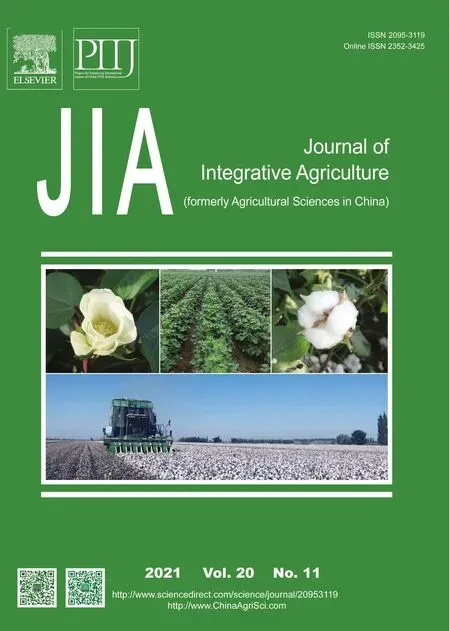Application of methyl jasmonate postharvest maintains the quality of Nanguo pears by regulating mitochondrial energy metabolism
2021-09-10LlCanyingCHENGYuanHOUJiabaoZHUJieSUNLeiGEYonghong
Ll Can-ying,CHENG Yuan,HOU Jia-bao,ZHU Jie,SUN Lei,GE Yong-hong
College of Food Science and Technology/National and Local Joint Engineering Research Center of Storage,Processing and Safety Control Technology for Fresh Agricultural and Aquatic Products,Bohai University,Jinzhou 121013,P.R.China
Abstract The present study was conducted to investigate the effects of methyl jasmonate (MeJA) dipping treatment on mitochondrial energy metabolism and quality parameters of Nanguo pears during room temperature storage.The results showed that MeJA treatment suppressed the respiration rate and weight loss,and maintained the flesh firmness of Nanguo pears.MeJA also effectively maintained the content of ascorbic acid and titratable acidity in the fruit.Furthermore,the activities of H+-ATPase,Ca2+-ATPase,succinate dehydrogenase (SDH) and cytochrome C oxidase(CCO) of the MeJA-treated fruit were significantly higher than those of the untreated fruit.The contents of adenosine triphosphate (ATP) and adenosine diphosphate (ADP) and the energy charge were also enhanced by MeJA treatment.These results suggest that postharvest MeJA treatment could maintain the quality of Nanguo pears,in part by modulating mitochondrial energy metabolism during room temperature storage.
Keywords:Pyrus ussuriensis,energy metabolism,methyl jasmonate,respiration rate
1.lntroduction
Nanguo pear fruit (PyrusussuriensisMaxim),which is mainly cultivated in Liaoning Province of China,is famous for its unique aroma and taste (Sunet al.2020).The storage life of Nanguo pears is generally less than 20 days at 20-25°C.The ripened fruit often show flesh browning and are readily infected by phytopathogens,causing tremendous economic losses.To date,low temperature storage can effectively delay the senescence of Nanguo pears and effectively prolong the shelflife.However,studies have demonstrated that Nanguo pears are quite sensitive to low temperature,and the peel is easily browned after transfer to room temperature(Shenget al.2016;Shiet al.2018).Previous studies have indicated that postharvest application of melatonin,1-methylcyclopropene,putrescine,and acibenzolar-Smethyl could effectively maintain the characteristics of the pears and postpone senescence (Geet al.2017;Xuet al.2018;Zhaiet al.2018;Singhet al.2019).
Methyl jasmonate (MeJA),a type of natural plant growth regulator,has been shown to be a signaling molecule which regulates various physiological processes,including plant growth and development,injury response,environmental stress resistance,and secondary metabolite accumulation (Luoet al.2020).MeJA can effectively alleviate soft rot in kiwifruit caused byBotryosphaeriadothidea,blue mould caused byPenicillium expansumandP.citrinumin pears and Chinese bayberry,and anthracnose caused byColletotrichumacutatumin loquat fruit (Zhanget al.2009;Caoet al.2010;Wanget al.2014;Panet al.2020).Studies have also shown that the application of MeJA postharvest could maintain the quality of mangosteen,kiwifruit,medlar,and ginger rhizomes (Mustafaet al.2016,2018;Li Het al.2017;D’Onofrioet al.2018;Liet al.2019;Ozturket al.2019).
Taking postharvest fruits and vegetables as examples,the energy status of the cells affects the changes in quality and physiological metabolism (Wanget al.2013;Linet al.2018).Meanwhile,the energy status plays a pivotal role in chilling tolerance and disease resistance of vegetables and fruits (Chenet al.2015;Liet al.2016).Sodium silicate treatment reduced the degree of decay inTrichotheciumroseuminfected muskmelons by increasing the activity of key enzymes in mitochondrial energy metabolism (Lyuet al.2019).Another study also showed that postharvest acibenzolar-S-methyl treatment inhibited the growth ofP.expansumin Nanguo pears,and increased the activity of related enzymes in energy metabolism and energy charge (Geet al.2017).Benzothiadiazole treatment could significantly reduce the infection ofP.expansumin apples and allowed them to maintain high levels of adenosine triphosphate(ATP) and energy status during storage (Liet al.2020).Previous studies suggested that the energy charge and endogenous ATP content in longan fruit could be increased by the exogenous application of ATP (Linet al.2017).Exogenous ATP maintains fruit quality of Nanguo pears after cold storage by regulating reactive oxygen species metabolism (Zhanget al.2018a).It has been reported that the energy metabolism of the fruit was improved by treatments with propyl gallate(Linet al.2018),trisodium phosphate (Geet al.2019)and chlorogenic acid (Shuet al.2020).However,the effects of MeJA treatment postharvest on the quality and mitochondrial energy metabolism of Nanguo pears have not fully elucidated to date.
The purposes of this study were to evaluate the changes of quality parameters in Nanguo pears after MeJA treatment,and to elucidate the relationships between quality changes and mitochondrial energy metabolism during storage at room temperature.
2.Materials and methods
2.1.Fruit and treatments
Nanguo pear fruit were collected at commercial maturity(flesh firmness and total soluble solid content were 27.7 N and 11.2%,respectively) from an orchard in Beizhen City (Liaoning Province,China),and transferred to the laboratory in cartons (60 fruit per carton) within 6 h.Fruit with a uniform size and free from pests and mechanical injuries were selected and separated randomly into two groups (210 fruit per group).One group (70 fruit in each of three replicates) was dipped in 100 µmol L-1MeJA(Solarbio Company,China) solution,an appropriate concentration as determined in a preliminary study,containing 0.1 mL L-1Tween-20 for 10 min,while the other group was soaked in aseptic distilled water (containing 0.1 mL L-1Tween-20) and used as the control.Another 90 pears were prepared by the same method and divided into two groups,which were specifically used for determining respiration rate.After natural air drying at(20±1)°C,all fruit were placed into plastic trays with 15 pears per tray and 10 trays for each treatment,and then maintained at (20±1)°C and 60-70% relative humidity.
2.2.Measurement of respiration rate
Forty-five fruits from each group were weighed and placed into three valve bags (15 fruit per bag) for 1 h at room temperature on days 0,2,4,6,8,10,and 12.A Portable Gas analyzer Check Point II (PBI-Dansensor Co.,Ltd.,Denmark) was used to determine the oxygen concentration in the bags,and the respiration rate was expressed as mL O2kg-1h-1.
2.3.Determination of flesh firmness and weight loss
Flesh firmness was assessed following the method of Duanet al.(2019) by removing the skin from the symmetrical surface at the equator of 15 fruit from the MeJA-treated and control groups and measured with a GY-1 hardness tester on days 0,2,4,6,8,10,and 12.Flesh firmness was expressed as Newton (N).Weight loss was measured following the method of Geet al.(2019) and expressed as percent (%).
2.4.Sample collection
Pulp tissues were collected on days 0,2,4,6,8,10,and 12 after treatment according to the method of Geet al.(2019).All the samples were maintained at -80°C prior to the biological assays.
2.5.Assays of ascorbic acid (AsA) content and titratable acidity (TA)
AsA content was assayed in line with the method of Geet al.(2019) and expressed as µg AsA g-1fresh weight(FW).TA was determined by the NaOH titration method(Wanget al.2019) and expressed as a percentage of malic acid.
2.6.Determination of the activities of Ca2+-ATPase,H+-ATPase,succinate dehydrogenase (SDH) and cytochrome C oxidase (CCO)
Crude mitochondria were extracted from the pulp tissues following the method of Jinet al.(2014) with minor modifications.Ten grams of pulp tissues were thoroughly ground into a homogenate in 30 mL of pre-cooled 100 mmol L-1Tris-HCl buffer (pH 7.5,containing 1.0 mmol L-1ethylene diamine tetraacetic acid,250 mmol L-1sucrose and 300 mmol L-1mannitol),and then centrifuged at 4 000×g (4°C) for 10 min.The supernatant was centrifuged for 30 min at 12 000×g(4°C).The precipitate was rinsed twice with Tris-HCl buffer and then suspended in 10 mmol L-1of pH 7.5 Tris-HCl buffer (containing 1.0 mmol L-1ethylene diamine tetraacetic acid,250 mmol L-1sucrose and 300 mmol L-1mannitol).The obtained suspension was used as the crude mitochondrial extract.
The activities of SDH,CCO,H+-ATPase and Ca2+-ATPase were assayed following the method of Geet al.(2017).The activities of CCO and SDH were represented as U mg-1protein,where 1 U=0.01ΔOD600min-1and 1 U=0.01ΔOD510min-1,respectively.ATPase activity was expressed as U mg-1protein,where 1 U represents the discharge of 1.0 µmol of phosphorus at 660 nm h-1.
The Bradford method (1976) was used to assay protein content on the same day as the enzymatic assays.
2.7.Assays for the contents of adenosine triphosphate (ATP),adenosine diphosphate (ADP) and adenosine monophosphate (AMP),and energy charge
The extraction and determination of ATP,ADP,and AMP contents in Nanguo pears were conducted by the method of Geet al.(2017).The contents of ATP,ADP and AMP were expressed as µg g-1FW,and Energy charge=(ATP+ADP)/(ATP+ADP+AMP).
2.8.Data analysis
All data were analyzed by the least significant difference(LSD) using one-way ANOVAviaSPSS Software (SPSS inc.,Chicago,USA) to determine the differences in the means (P<0.05).
3.Results
3.1.Changes of respiration rate,weight loss and flesh firmness in Nanguo pears
Nanguo pears have an obvious climacteric peak in respiration on day 8 after treatment (Fig.1-A).The respiration rate was distinctly suppressed by MeJA treatment on days 6-10.The respiration rate of the control fruit was 1.24-times higher than that of the MeJA-treated fruit on day 8.Weight loss was gradually increased on days 0-12,but the weight loss in the MeJAtreated fruit was similar in comparison with the control(Fig.1-B).Flesh firmness decreased in both the MeJAtreated and control fruit during storage,but the MeJA treatment remarkably inhibited the decline of flesh firmness on days 4-12 (Fig.1-C).Flesh firmness in the MeJA-treated fruit was 4.18-times higher than in the control fruit on day 12.
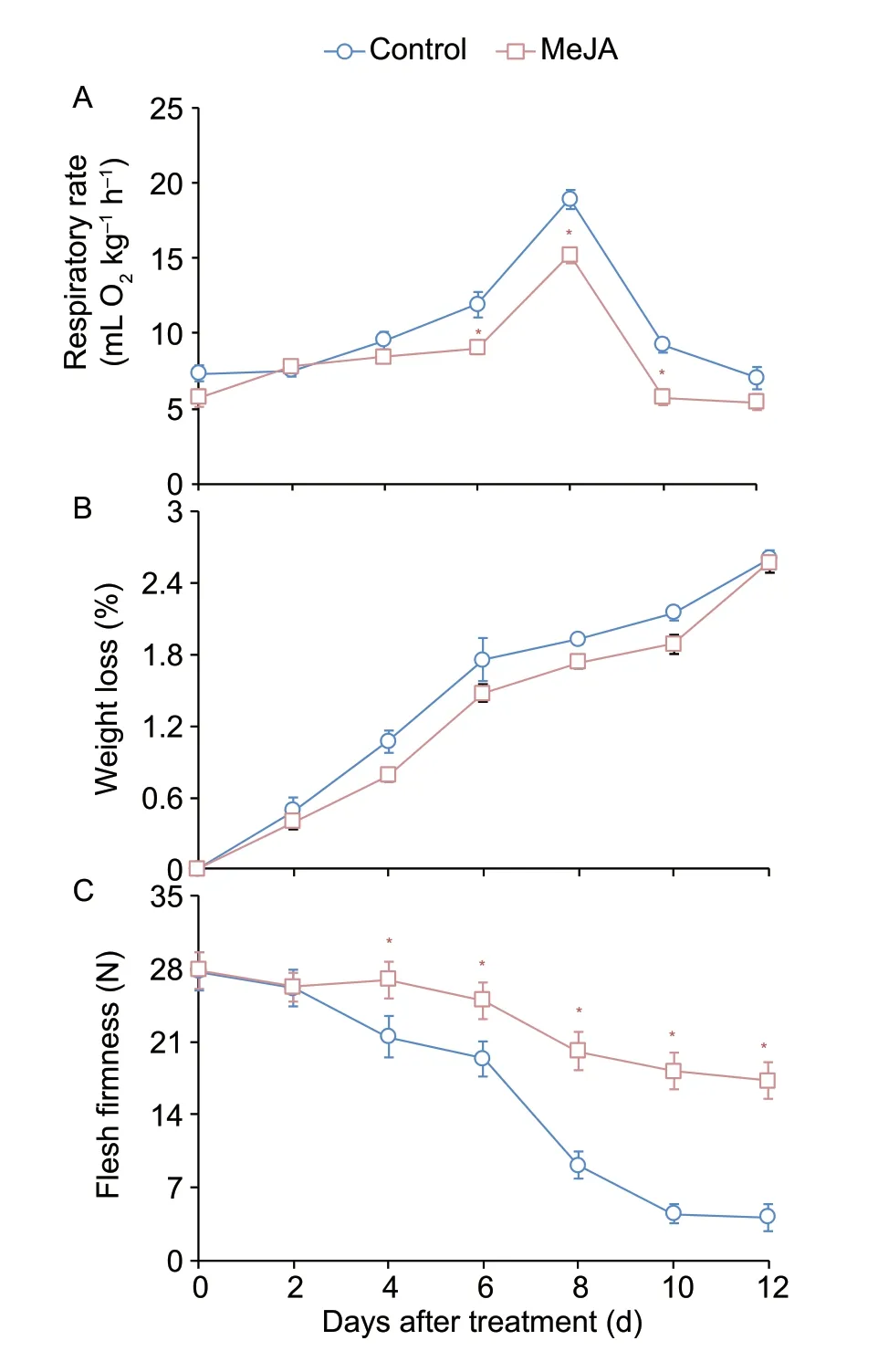
Fig.1 Effects of methyl jasmonate (MeJA) treatment on respiration rate (A),weight loss (B) and flesh firmness (C) of Nanguo pears during storage at (20±1)°C and 60-70% relative humidity.Vertical bars represent standard errors (n=3).Asterisk(*) represents significant differences at the level of 0.05.
3.2.Changes of AsA content and TA in Nanguo pears
AsA content in the MeJA-treated fruit increased on days 0-6 and decreased on days 6-12,while in the control fruit it showed an upward trend on days 0-2 and a downward trend in the following days (Fig.2-A).However,the AsA level in the fruit treated with MeJA was remarkably higher than the level in the control fruit on days 2-12.The peak value of AsA content in the fruit treated with MeJA was 1.56-times higher than in the control fruit.TA in both the MeJA-treated and control fruit increased on days 0-6,and declined in the subsequent period,and MeJA treatment maintained a distinctly higher level of TA in Nanguo pears on days 2 and 6-12 (Fig.2-B).
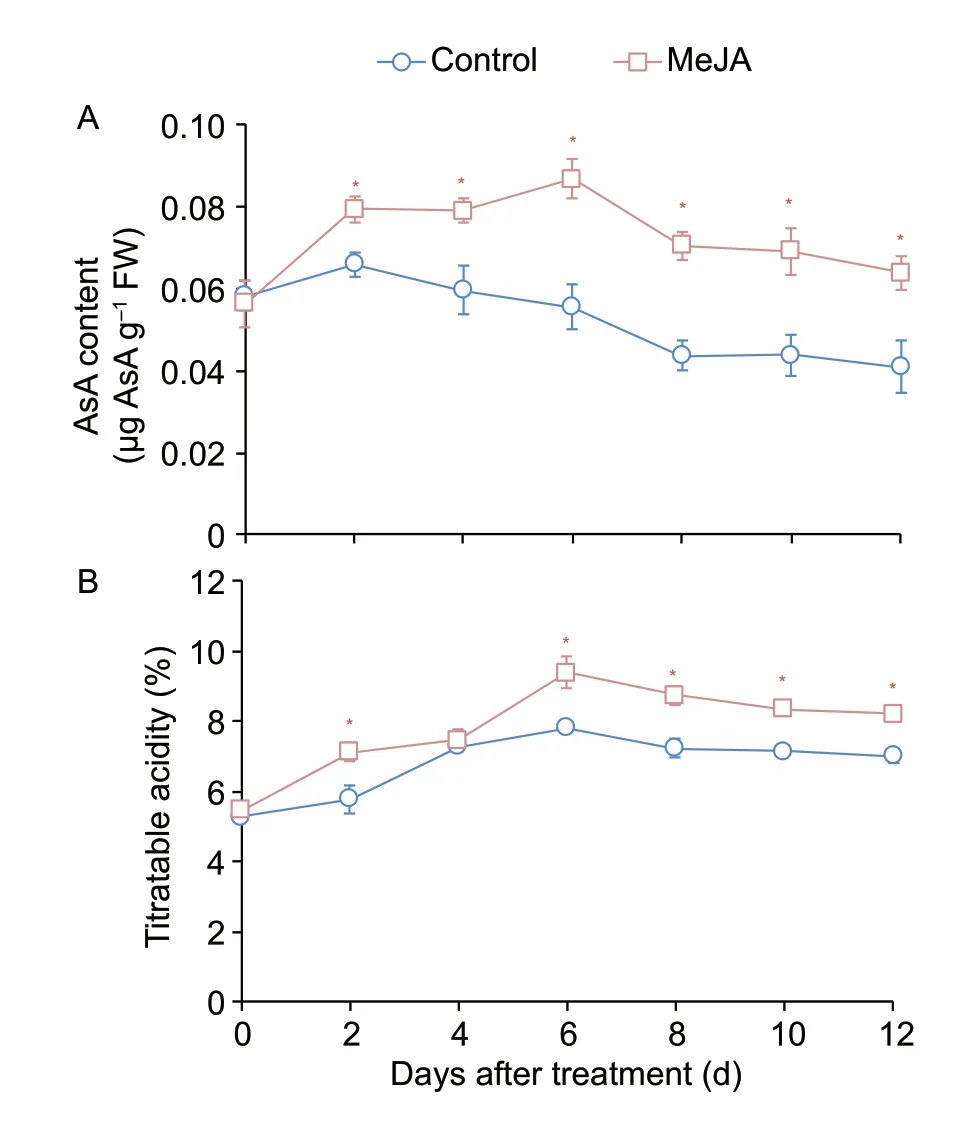
Fig.2 Effects of methyl jasmonate (MeJA) treatment on ascorbic acid (AsA) content (A) and titratable acidity (B) in Nanguo pears during storage at (20±1)°C and 60-70% relative humidity.Vertical bars represent standard errors (n=3).Asterisk(*) represents significant differences at the level of 0.05.
3.3.Changes of the activities of H+-ATPase and Ca2+-ATPase in Nanguo pears
The activities of H+-ATPase and Ca2+-ATPase gradually declined throughout the storage period (Fig.3-A and B).H+-ATPase and Ca2+-ATPase activities were remarkably enhanced by MeJA dipping treatment on days 4-12 (Fig.3-A and B).The activities of H+-ATPase and Ca2+-ATPase in the fruit treated with MeJA were 1.62-and 1.81-times higher than in the control fruit on day 12,respectively.
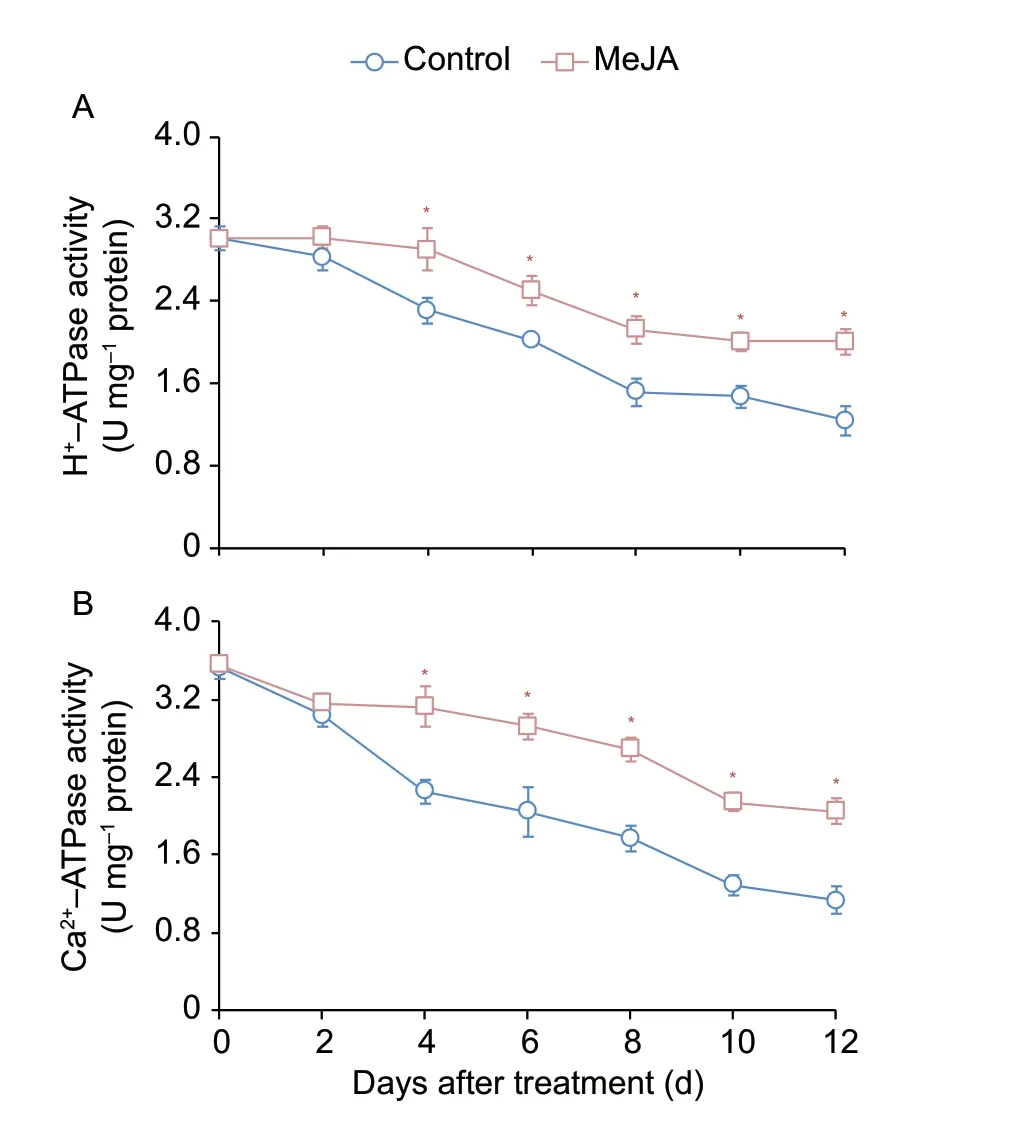
Fig.3 Effects of methyl jasmonate (MeJA) treatment on the activities of H+-ATPase (A) and Ca2+-ATPase (B) in Nanguo pears during storage at (20±1)°C and 60-70% relative humidity.Vertical bars represent standard errors (n=3).Asterisk (*)represents significant differences at the level of 0.05.
3.4.Changes of SDH and CCO activities in Nanguo pears
SDH activity gradually decreased in both the MeJAtreated and control pears on days 0-12 (Fig.4-A).The activity of SDH was distinctly higher in the fruit treated with MeJA compared to the control fruit on days 2-12.CCO activity in the fruit treated with MeJA increased on days 0-6 and then decreased in the subsequent days,while CCO activity in the control fruit increased on days 0-4 and then decreased on days 4-12 (Fig.4-B).CCO activity in the fruit treated with MeJA was significantly higher in comparison with the control fruit on days 2-12.
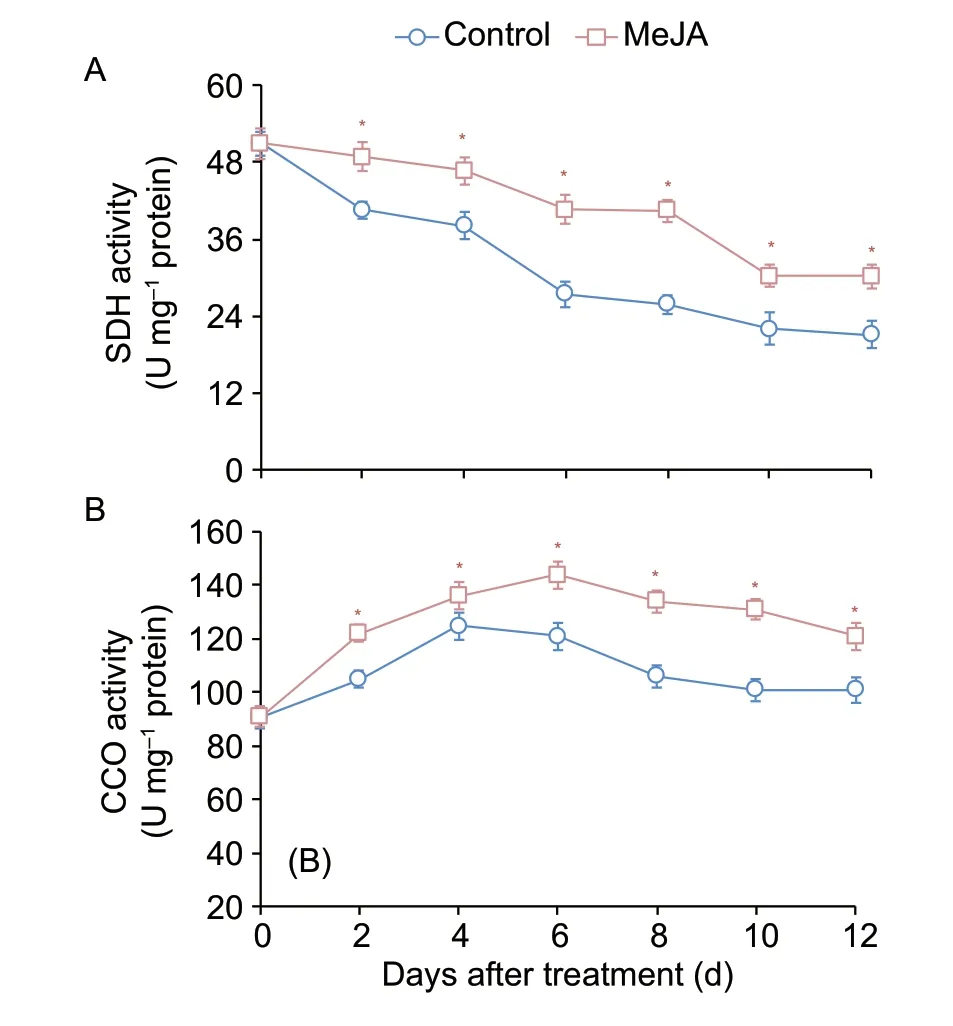
Fig.4 Effects of methyl jasmonate (MeJA) treatment on the activities of succinate dehydrogenase (SDH;A) and cytochrome C oxidase (CCO;B) in Nanguo pears during storage at (20±1)°C and 60-70% relative humidity.Vertical bars represent standard errors (n=3).Asterisk (*) represents significant differences at the level of 0.05.
3.5.Changes of ATP,ADP,and AMP contents and energy charge in Nanguo pears
ATP content decreased with the progression of the storage period,and was distinctly higher in the MeJAtreated pears than in the control pears on days 4-12(Fig.5-A).ADP content in the MeJA-treated and untreated fruit increased on days 0-4 and decreased in the subsequent days (Fig.5-B).MeJA treatment distinctly enhanced ADP content in Nanguo pears on days 2-12.AMP content in both the control and MeJA-treated fruit increased on days 0-12,but the MeJA dipping treatment remarkably reduced the AMP content in pears on days 4-12 (Fig.5-C).Energy charge decreased in both the control and MeJA-treated pears on days 0-12,but MeJA treatment caused the pears to maintain a remarkably higher level of energy charge on days 4-12 (Fig.5-D).
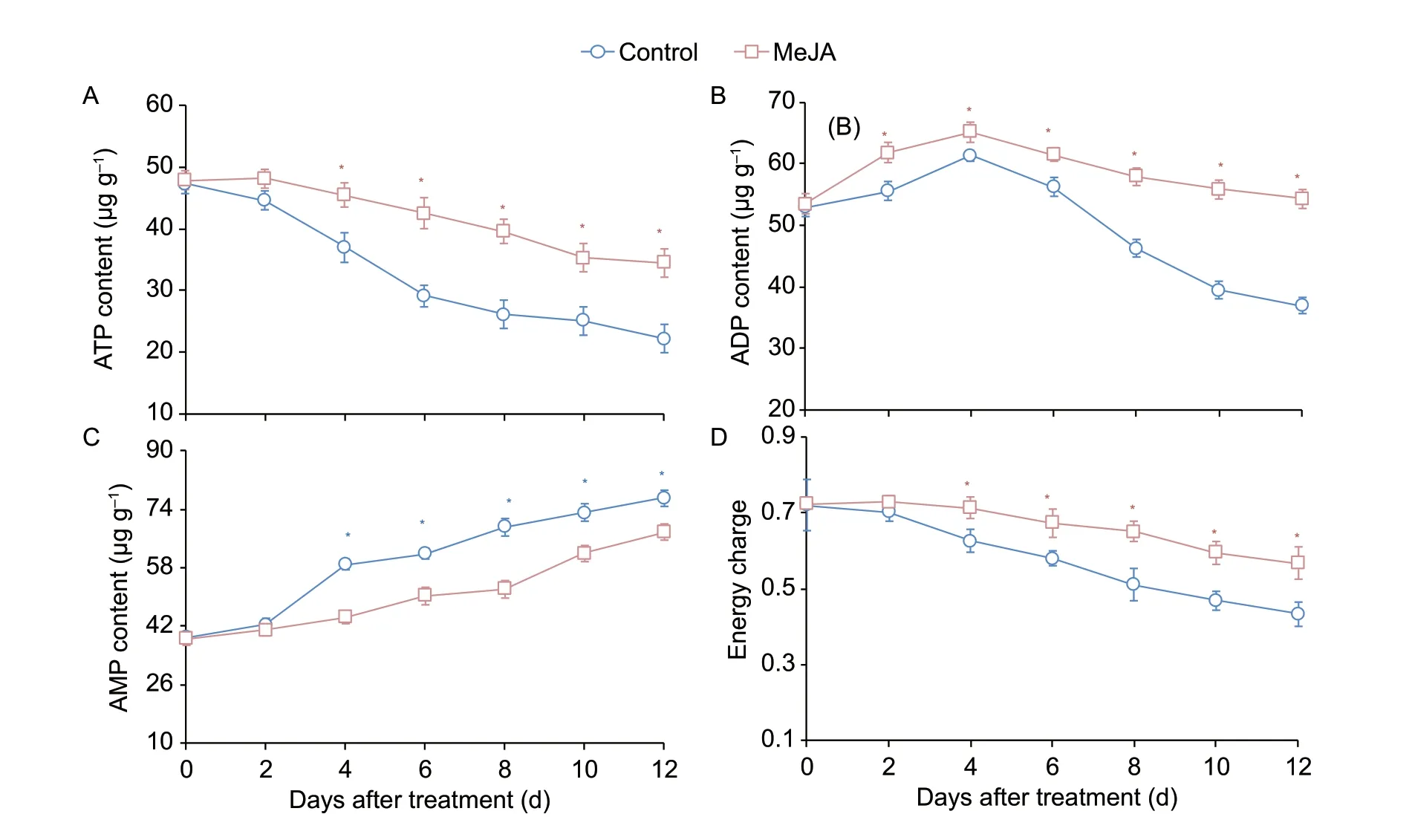
Fig.5 Effects of methyl jasmonate (MeJA) treatment on adenosine triphosphate (ATP;A),adenosine diphosphate (ADP;B) and adenosine monophosphate (AMP;C) contents and energy charge (D) in Nanguo pears during storage at (20±1)°C and 60-70%relative humidity.Vertical bars represent standard errors (n=3).Asterisk (*) represents significant differences at the level of 0.05.
4.Discussion
Mitochondrial energy metabolism is closely related to senescence,physiological disorders and resistance to biotic stresses in fruits and vegetables.Weight loss is one indicator of senescence,which is mainly influenced by respiration and transpiration processes (Hunget al.2011).The current study showed that MeJA treatment reduced the weight loss of Nanguo pears,but there was no significant difference compared with the control fruit.This might be due to the application of MeJA postharvest maintaining the cellular integrity and inhibiting water evaporation.It has been proven that the maintenance of cell membrane semi-permeability reduces the loss of intracellular water,ions and metabolites (Greirson 2006;Menget al.2009).This was also consistent with the reduced weight loss in ‘Kinnow’ mandarins after postharvest application of MeJA (Baswalet al.2020).It was also similar to the earlier report that weight loss of pear treated with putrescine was lower than the control during storage (Singhet al.2019).
The reduction of flesh firmness is the most obvious sign of deterioration in fruit quality.Pectin esterase,pectin methyl esterase (PME),cellulase and polygalactouronase degrade the cell walls which reduces flesh firmness during storage (Menget al.2009;Baswalet al.2020).This study demonstrated that MeJA treatment had a significant inhibitory effect on flesh firmness,suggesting an important role of MeJA in maintaining the structure of cell walls and delaying fruit softening.A similar study indicated that MeJA treatment extended the storage life and maintained higher firmness of ‘Kinnow’ mandarin fruit,and kept lower levels of PME and cellulase activities (Baswalet al.2020).Saracogluet al.(2017) also reported that MeJA treatment could improve the quality of sweet cherry fruit and enhance pulp firmness.MeJA treatment also maintained higher firmness in peaches by regulating the activity of cell wall modifying enzymes (Menget al.2009).Studies have shown that applying MeJA after harvest slows down the fruit softening,which might be related to its effect on maintaining cell integrity and regulating the activity of cell wall hydrolyzing enzymes (Baswalet al.2020;Panet al.2020).However,a different result was reported in ‘Cripps Pink’ apples,in which application of MeJA had little effect on pulp firmness (Shafiqet al.2011).Taken together,these results suggested that the effect of MeJA treatment on flesh firmness might also vary among different species.
The organic acid content decreases with the maturation and senescence of fruits and vegetables after harvest(Selcuk and Erkan 2015).This study found that MeJAtreated Nanguo pears retained a higher level of acidity in comparison with the control fruit.The decrease in TA was caused by either the inhibition of organic acid synthesis or the consumption of organic acids as substrates of respiration.A previous study has proven that the increase in respiration rate could consume organic acids(Huanet al.2016).Similar studies have found that postharvest MeJA treatment maintained a higher level of TA in mandarins and strawberries (Geransayehet al.2015;Baswalet al.2020).AsA is a key nutrient in fruits and vegetables for human health,and also an important non-enzymatic antioxidant in the AsA-GSH cycle,which eliminates reactive oxygen species.Studies have shown that increasing the antioxidant content in fruit could effectively delay fruit ripening and senescence (Geet al.2018).The present study found that MeJA treatment maintained a higher level of AsA in Nanguo pears.A study in broccoli indicated that postharvest application of MeJA delayed the quality decline and yellowing by enhancing the AsA content,improving the activity of antioxidant enzymes during transportation and storage(Xuet al.2020).Maftoonazadet al.(2008) found that the higher AsA content in peaches could be caused by a decrease in the activity of ascorbic acid oxidase and the delaying of the maturation and senescence process.All these results suggest that maintaining higher levels of TA and AsA contents were closely related to the senescence of fruits and vegetables.
The respiration rate is generally considered to be a key attribute of postharvest vegetables and fruits,and is closely related to soluble sugar content.During storage,the energy produced by respiration could sustain life activities and various physiological reactions of the fruits and vegetables (Li Let al.2017).The current study demonstrated that the peak value of the respiration rate of Nanguo pears was significantly depressed by MeJA treatment on day 8.This result agreed with the previous reports where the respiration rates of medlar fruit and Nanguo pears were suppressed by MeJA and CaCl2treatments (Ozturket al.2019;Zhanget al.2019).It has also been demonstrated that 1-MCP reduced the respiration rate in ‘Comice’ pears by limiting the expression of genes associated with ethylene synthesis(Zhaoet al.2020).However,there are also studies which showed that applying MeJA at the beginning of mango maturation could improve the respiration rate,but it had no significant effect when applied at the climacteric stage (Lalelet al.2003).These results suggested that the impact of MeJA on respiration rate varies among the different maturity levels or varieties.
Sugar and organic acid are not only important quality parameters in fruits and vegetables,but also the main substrates of primary metabolism.A higher respiration rate of fruits and vegetables also causes more sugar and organic acids to be used and transformed,which leads to an accelerated senescence of horticultural products.A study has reported that sweet cherries treated with melatonin showed decreased respiration rate and slower decreases of soluble sugar content,AsA content and TA,thus delaying senescence and maintaining better quality (Wanget al.2019).Gaoet al.(2013) also found that a chitosan-glucose complex coating on grapes had beneficial effects on postponing the decreases of soluble solids and organic acids contents,and also inhibited the respiration rate.In this study,we found that exogenous application of MeJA delayed the declines of AsA content and TA,and inhibited the respiration rate of Nanguo pears.
Sufficient energy not only increases disease resistance,but also delays senescence of fruits and vegetables,and maintains fruit quality (Yiet al.2008).Our study showed that MeJA treatment increased the ATP and ADP contents as well as the energy charge in Nanguo pears,suggesting that MeJA could delay ripening and senescence by regulating energy metabolism.Previous studies have shown that exogenous ATP treatment could effectively increase the contents of ADP and ATP and the level of energy charge in the cells,and regulate sucrose metabolism to affect the quality of Nanguo pears (Duanet al.2019).A similar result was reported by Taoet al.(2019) who found that the higher levels of ATP and energy charge were observed in 1-MCP-treated Nanguo pears.Zhang (2018b) and co-workers proved that exogenous application of ATP could suppress the senescence and peel browning of Nanguo pears by delaying the decreases of ATP content and energy charge.Similarly,acibenzolar-S-methyl-treated Nanguo pears maintained the higher ATP level,which played a major role in senescence,quality maintenance and disease resistance during storage (Geet al.2017).All these results suggest that maintaining a higher level of energy charge is closely related to fruit senescence.
The changes of energy level were affected by the activities of enzymes in energy metabolism.ATP is the major energy storage substance in cells,and its synthesis,transport and utilization usually require the participation of Ca2+-ATPase,H+-ATPase,SDH and CCO(Taoet al.2019).ATPase located on the mitochondrial membrane is referred to as the key enzyme which plays a crucial role in the oxidative phosphorylation pathway,and energy synthesis and supply (Linet al.2018).Energy released by H+-ATPase hydrolysis of ATP is used to transport protons,generating electrochemical protons and regulating mitochondrial pH,while Ca2+-ATPase is used to transport Ca2+from the cytoplasm to the mitochondrial matrix (Zhanget al.2018b).Therefore,ATPase is critical for maintaining mitochondrial function and integrity as well as cellular energy homeostasis.SDH and CCO are the key enzymes in the tricarboxylic acid cycle and the terminal enzyme of the respiratory electron transport chain,respectively,which are beneficial to ATP synthesis(Jinet al.2014;Panet al.2019).Low SDH and CCO activities could lead to the disordering of intracellular energy metabolism,aggravate cell senescence and lower fruit quality.Recent studies have shown that browning of longan fruit was associated with an inadequate cellular energy supply through decreases of H+-ATPase,Ca2+-ATPase SDH,and CCO activities (Linet al.2018).Postharvest applications of melatonin,chlorine dioxide,trisodium phosphate,oxalic acid and ATP have been proven to maintain high levels of ATP in litchis (Wanget al.2013),longan fruit (Vichaiyaet al.2020),apples(Geet al.2019),peaches (Jinet al.2014),and pears(Zhanget al.2018b).Our results indicated that the activities of H+-ATPase,Ca2+-ATPase,SDH and CCO in Nanguo pears were enhanced by MeJA treatment.Li(2018) and co-workers found that postharvest MeJA treatment prolonged the storage period of dragon fruit by regulating glucose and energy metabolism.Geet al.(2017) also found that an acibenzolar-S-methyl dipping treatment increased the activities of ATPase,SDH and CCO in pears and enhanced disease resistance.Taken all together,these lines of evidence have proven that the higher ATPase,SDH and CCO activities in the fruit treated with MeJA could improve the energy level,which is beneficial for delaying senescence and maintaining fruit quality.
5.Conclusion
MeJA treatment could enhance the mitochondrial energy metabolism to maintain a higher level of ATP in the cells,which was beneficial for maintaining fruit quality and prolonging the shelf-life of Nanguo pears during room temperature storage.
Acknowledgements
This study was supported by the National Natural Science Foundation of China (31801595) and the Firstclass Discipline Project of Liaoning Province,China(LNSPXKBD2020205).
Declaration of competing interest
The authors declare that they have no conflict of interest.
杂志排行
Journal of Integrative Agriculture的其它文章
- Errata regarding previously published articles
- Viricidal activity of several disinfectants against African swine fever virus
- Melatonin treatment induces chilling tolerance by regulating the contents of polyamine,γ-aminobutyric acid,and proline in cucumber fruit
- Linking changes in the soil microbial community to C and N dynamics during crop residue decomposition
- Modification of total and phosphorus mineralizing bacterial communities associated with Zea mays L.through plant development and fertilization regimes
- Yield performance and optimal nitrogen and phosphorus application rates in wheat and faba bean intercropping
